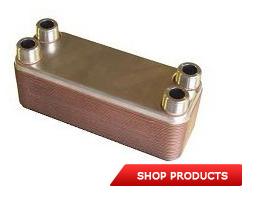Beer and Wort Plate Chiller
Brewing beer at home has been popular in USA for several decades now and this has traditionally been done using copper wort chillers. However, in the recent years, plate chillers (or Beer and Wort plate chillers) have become extremely popular owing to their several advantages over traditional wort chillers.
 But before we go deeper into the advantages, it is important to know why we need chillers in the first place. Beer making usually follows the following steps –
But before we go deeper into the advantages, it is important to know why we need chillers in the first place. Beer making usually follows the following steps –
- Malting
- Milling
- Mashing
- Brewing
- Cooling
- Fermentation
- Racking
- Finishing
And, boiling is that one step which determines the color, flavor and aroma of the beer to be produced. Equally important step is cooling where the hot wort must be rapidly cooled in order to bring it down to a temperature which favors the growth of yeast. Too high a temperature and the yeast will die off, too cold a temperature and the yeast will be rendered inactive. Yeast is responsible for converting the sugar molecules in the wort into alcohol and this is why maintaining optimum temperature of the wort becomes all the more important.
So, what role does a heat exchanger play here? Well, a beer and wort plate chiller here plays a very vital role in maintaining the temperature of the wort at an optimum level. Above all, a chiller also ensures that the boiling wort is cooled quickly so that the beer does not lose its flavor and aroma. Fermentation usually starts at around 20 deg C and the boiling wort can be as hot as 90 deg C. A good quality beer and wort chiller can bring down the temperature from 90 deg C to about 20 deg C in just a few minutes.
Traditionally an all Copper tube like heat exchanger was used. However, it was inconvenient as well as less hygienic as compared to the modern day beer and wort plate chillers. In addition to this, beer and wort plate chillers occupy much less space and are much more efficient when compared with traditional chillers.
Beer and wort plate chillers’ most commonly available size is 3”x8” (width x length). The chiller features an inlet and an outlet for the wort as well as for the cooling liquid which is usually water. The adapter from which cooling fluid flows is usually referred to as the MPT (Male Pipe Thread) since it is bigger (about ¾ inch) than the Wort adapter, usually referred to as FPT (Female Pipe Thread), which is about ½ inch in diameter.
Male pipe thread is designed with a diameter of ¾ in keeping in mind the diameter of garden hose pipes commonly used at home. All that you have to do is pass cooling fluid from one end and the heated wort from another end. The two never interact directly with each other and heat is simply carried away by the cooling fluid efficiently owing to high turbulence that is created by brazed plates.
You may also want to use a Thrumometer in order to monitor and better control the temperature of wort. A Thrumometer has hose fittings on either sides and indicates the temperature of the wort flowing through it. Knowing the exact temperature of wort can help you decide when you should introduce yeast in order to have the best possible fermentation of your beer.





